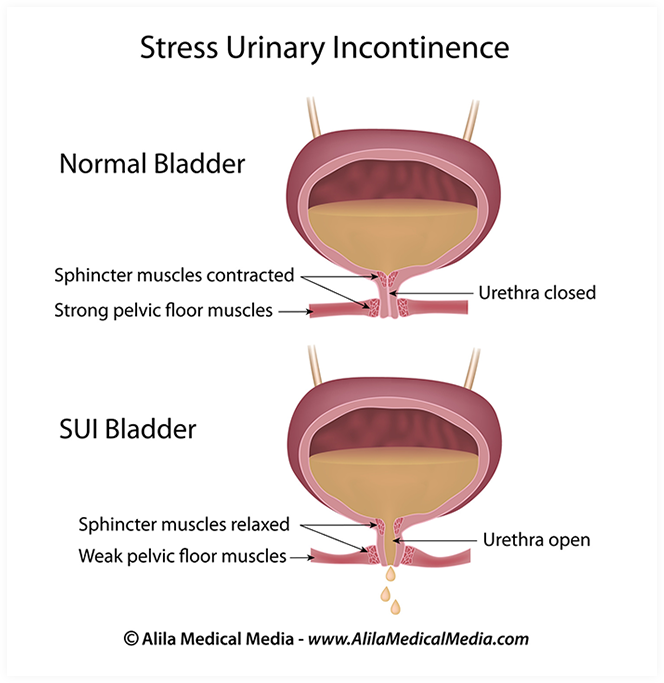Stress Incontinence
What is stress incontinence?
Do you sometimes feel a little leak of urine when you laugh really hard, sneeze or cough suddenly, or when you exercise? This is called stress incontinence, and it happens when pressure from these actions pushes down on the bladder, such that a small amount of urine squirts through the bladder opening, called the bladder neck. The bladder outlet is normally kept closed by an internal sphincter at the bladder neck, collagen around the urethra, and the pelvic floor muscles on the outside of the urethra. When it is an appropriate time to urinate, the pelvic floor muscles relax and the sphincter opens, allowing you to empty the bladder.

Why does it happen?
So why does the bladder allow urine to leak when it’s not supposed to? Sometimes pressure on the bladder overwhelms the closure and support mechanisms that keep you continent. Laxity of the pelvic floor musculature can occur from pregnancy, childbirth, weight gain, and excessive straining from vigorous exercise or bearing down. At menopause, the urethra loses some of the collagen and has a less robust blood supply, which can decrease the support. Additionally, some women may genetically have weaker collagen and be more prone to stress incontinence.
This condition is extremely common in women and it is important to know that there are various ways to treat it, or dramatically improve the frequency and severity of it. Many women experience stress incontinence after childbirth and are told it will improve. There are various ways women can actively rehabilitate their pelvic floor muscles to prevent urinary leakage and the pelvic organs from sagging down.
What can I do about it?
Dr. Kumar will take a thorough history and perform a physical exam, often with a full bladder, to determine what factors are contributing to your leakage and how severe it is. Treatment is directed at the underlying factors and individualized for each patient. Dr. Kumar will evaluate if there are any medications, lifestyle factors, medical problems, or other urologic issues contributing to the problem. Some women have not only stress incontinence, but also have an overactive bladder or recurrent urinary tract infections, which need to be treated in conjunction with the stress incontinence. Some women may also be experiencing other symptoms related to perimenopause or menopause, which should also be addressed as a part of treating the whole patient, instead of treating just one problem out of the context of the overall picture.
Often, working with a good pelvic floor physical therapist can help to strengthen the pelvic floor muscles. A lot of women refer to this as “doing kegels.” However, when women are instructed to do kegel exercises at home on their own, they often do not see any change and feel the exercises are ineffective. Dr. Kumar emphasizes the need to do this type of therapy in conjunction with a specialist and can also guide you through devices which enable you to do the exercises at home, to achieve the maximum benefit and avoid further procedures or surgery.
In addition to pelvic floor physical therapy and intravaginal devices to help support the bladder neck, there are office procedures which can help to restore the collagen supporting the bladder neck and vaginal walls, and will additionally stimulate the tissue to build new collagen. This works well for women with mild to moderate stress incontinence. We also perform urethral injections, which are similar to dermatologic “fillers.” These can provide more volume on the inside of the urethra and create a tighter seal to prevent leakage. If these conservative and minimally invasive options not working well enough, there is a surgical procedure which is 80-90% effective at fixing the problem.


 / 53 Reviews
/ 53 Reviews
